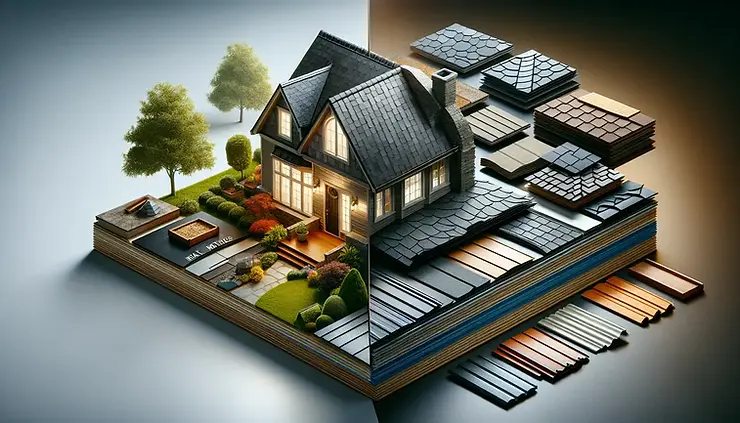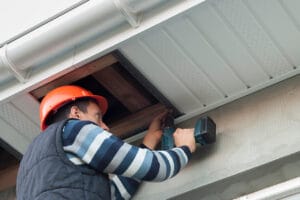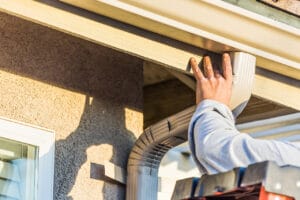Introduction to Roofing
Materials When talking roofs, think beyond just a cover for your house. It’s a big decision impacting your home’s look, efficiency, and resistance to the elements. You’ve got options, plenty. From classic asphalt shingles to metal, clay tiles, and beyond, each material brings its vibe and set of pros and cons. Asphalt shingles, the go-to for many, are affordable and work well in various climates. Metal roofs, though pricier, shine in durability and energy efficiency. Clay tiles add a Mediterranean charm but come heavy on the pocket and the structure. And then, there’s composite roofing. A blend of materials, it’s rising as a favorite for balancing looks, cost, and longevity. Dive in as we peel the layers off these roofing choices, zeroing in on why composite roofs are stealing the show for homeowners.

What is a Composite Roof?
A composite roof is made from a mix of several materials, including fiberglass, recycled paper products, and asphalt. This blend gives composite roofs a big advantage; they can mimic the look of wood shake, slate, or even tile roofs but without the drawbacks of those materials. So, you’re getting a sturdy, weather-resistant roof that looks just like the more expensive options. What’s more, these roofs are lighter, which means less stress on your home’s structure. They’re also less of a hassle to install, and because they’re made of a mix, they’re often more environmentally friendly. Plus, they’re tough. Composite roofs can stand up to wind, rain, and sun, making them a solid choice for just about any climate. Simplified, choosing a composite roof means you get the best bits of other materials, without the downsides, all while doing a bit of good for the planet.
Benefits of Choosing a Composite Roof for Your Home
Choosing a composite roof for your home offers numerous benefits, making it a standout choice among roofing materials. First off, composite roofs boast impressive durability. They’re engineered to withstand severe weather conditions, from scorching heat to freezing cold, ensuring your home stays protected for years. This resilience translates to less maintenance and repair costs over time. Additionally, composite roofs exhibit superior aesthetic flexibility. Manufacturers can mimic the look of slate, wood shakes, or even tile, giving you the beauty of traditional materials without their downsides. These roofs also come in a variety of colors, fitting any home style or personal preference. Another compelling advantage is the eco-friendliness of composite roofing. Made from recycled materials, these roofs are an excellent option for homeowners looking to reduce their environmental footprint. Plus, their energy efficiency is notable. Composite roofs reflect more sunlight than conventional roofing, helping keep your home cooler during hot months and reducing your energy bills. Finally, considering installation and lifespan, composite roofs are cost-effective. They’re lighter than traditional materials, which often means a quicker and less expensive installation process. And with a lifespan of 30 to 50 years, coupled with long-term warranties, the initial investment in a composite roof pays off over time. Whether you’re aiming for durability, aesthetic appeal, sustainability, or value, a composite roof checks all the boxes.
Durability and Lifespan of Composite Roofs
Choosing the right roofing material can make your home safer and save money in the long run. Composite roofs are a hot pick for many because they last a long time and can handle what nature throws their way. Composite roofs are made of a mix of materials like fiberglass, recycled paper products, and asphalt. This blend gives them the ability to stand strong against harsh weather, be it blazing sun, heavy rain, or even snowstorms. A well-installed composite roof can last you about 30 to 50 years. That’s a good deal of time before you need to think about replacing it. Plus, they don’t give up easily under UV rays, which means they keep their color and strength for years. It’s a smart choice for homeowners looking for reliability without constant worry or cost.
The Aesthetic Appeal of Composite Roofs
Composite roofs aren’t just tough; they look good too. They replicate the charm of traditional materials like wood shakes, slate, or tile without the hefty price tag or maintenance fuss. These roofs can match almost any home style, making them a hit among homeowners who care about curb appeal. Plus, you get a palette of colors and textures to choose from, so finding the perfect match for your house is simple. The beauty of composite roofs extends beyond the surface – these materials blend in with many neighborhood vibes, whether you’re going for sleek and modern or cozy and traditional. All in all, composite roofs bring the best of both worlds: durability and design, keeping your house both safe and stylish.
Comparing Costs: Composite Roof vs. Other Roofing Materials
When you’re looking at the cost of roofing materials, composite roofs are often seen as the mid-road option. They aren’t the cheapest, but they also don’t hit your wallet as hard as some high-end options. A composite roof, known for its durability and lifespan of about 30 to 50 years, can vary widely in cost. But on average, you’re looking at $4 to $6 per square foot installed. This might seem steep, but let’s not forget that you’re paying for resilience against weather and less frequent replacements. In contrast, traditional asphalt shingles are easier on your budget initially at $1.50 to $5.50 per square foot but expect to replace them every 15 to 20 years. Metal roofing steps up the game in cost and durability, ranging from $5 to $14 per square foot, promising a solid 40 to 70 years overhead. Slate and clay tiles top the chart, not just in lifespan (well over 100 years) but in expense too, hitting $10 to $30 per square foot. So, when comparing costs, it’s not just about what you pay today. Think durability. Think maintenance. Over time, a composite roof offers a sweet spot of affordability, longevity, and ease of maintenance that makes it a top choice for homeowners looking to invest smartly in their rooftops.
Maintenance and Repair: What to Expect with a Composite Roof
Composite roofs stand out for their low maintenance hustle. You won’t be up on a ladder every year fixing or checking them. They’re made tough, resisting impacts from hail or branches. So, say goodbye to the frequent repairs that come with other materials. But let’s keep it real, no roof is invincible. Over decades, you might see some wear or need minor fixes. Good news, though – repairs on composite roofs aren’t a huge deal. Usually, it’s just about replacing a shingle or two, not redoing the whole roof. Plus, these roofs last. We’re talking 30 to 50 years, easy. Compared to others, you’re getting more chill years, with fewer repair bills. And honestly, who wouldn’t want that?
Installation Process of Composite Roofs
Installing composite roofs doesn’t need to be a headache. First, a professional roofer checks your home’s current roof to ensure it’s ready for the new materials. They strip off the old roofing, repair any damage, and make sure the roof deck is solid. Next, they lay down a water-resistant barrier. This step is key to protecting your home from water damage. After the barrier, roofers install the composite shingles. Unlike heavy tile or metal, composite materials are lightweight and easier to handle, which means faster installation and less stress on your home’s structure. The process wraps up with the installation of ridge vents and flashing to assure proper ventilation and water proofing. Sure, weather and house size can influence how long the job takes. However, the efficiency of installing composite materials often means your roof can be done quicker compared to traditional materials. Quick, efficient, and done right. That’s the scoop on installing composite roofs.
Environmental Impact of Composite Roofing
When it comes to being kind to our planet, not all roofing materials are created equal. Composite roofing stands out for several good reasons. First off, these roofs are made from recycled materials, mixing plastics and rubber with other bits that would otherwise end up in a landfill. That’s a big win for the earth. Plus, because they’re designed to last longer than many traditional materials—think 30 to 50 years—the need to replace them isn’t as frequent. This long life reduces waste over time and means fewer resources are needed for repairs or new installations. What’s more, because composite shingles can be crafted to mimic the look of wood, slate, or other materials, they offer the beauty homeowners seek without cutting down more trees or mining the earth. And when it comes to saving energy, they’ve got it covered. Many of these products are designed to reflect solar heat, not absorb it, helping to keep homes cooler during hot months without cranking up the air conditioning. So, choosing composite roofing is a way to lessen your footprint while keeping your home looking sharp.
Conclusion: Why Composite Roofs Stand Out Among Homeowners
Composite roofs outshine their competitors for several reasons. First, they boast a durability that beats most materials, handling extreme weather like champs. This means homeowners can rest easy knowing their roof is less likely to need frequent repairs or succumb to environmental damages. Secondly, composite roofing mimics the look of more expensive materials like slate or wood shakes without draining your wallet, making it a win-win for those aiming for curb appeal on a budget. They’re also environmentally friendly, composed of recycled materials, and can be recycled at the end of their life cycle, marking a significant point for eco-conscious homeowners. Lastly, their ease of installation and maintenance makes them a practical choice, saving time and money in the long run. In the grand competition of roofing materials, composite roofs score high across the board, from durability and cost-efficiency to aesthetics and environmental impact.





